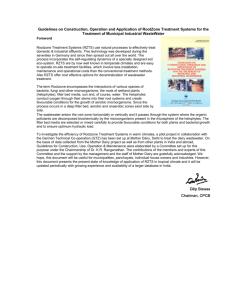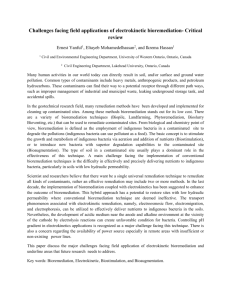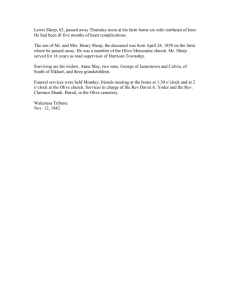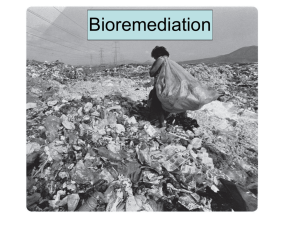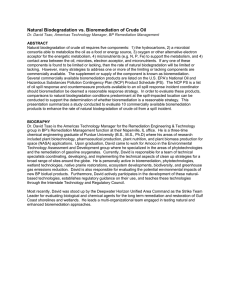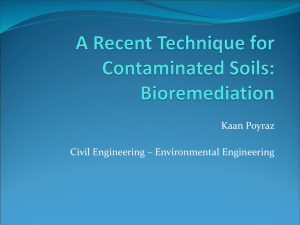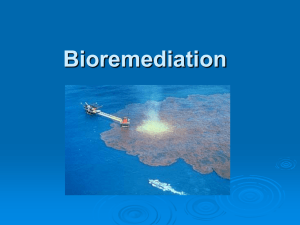Research Journal of Applied Sciences, Engineering and Technology 5(6): 2255-2263,... ISSN: 2040-7459; e-ISSN: 2040-7467
advertisement
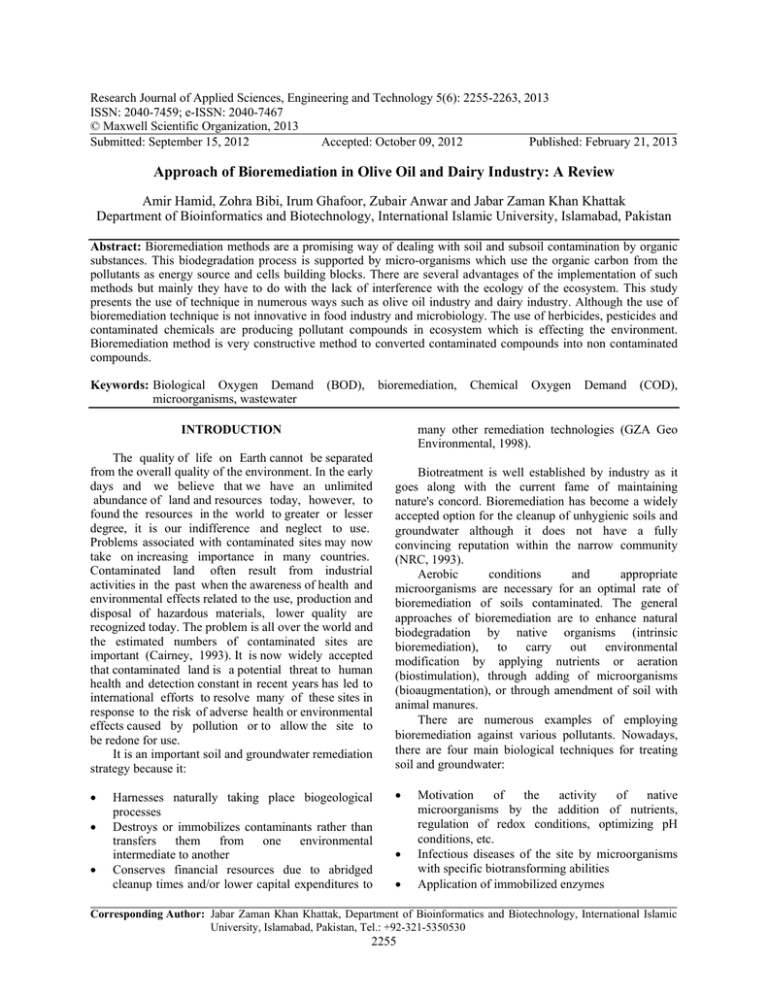
Research Journal of Applied Sciences, Engineering and Technology 5(6): 2255-2263, 2013 ISSN: 2040-7459; e-ISSN: 2040-7467 © Maxwell Scientific Organization, 2013 Submitted: September 15, 2012 Accepted: October 09, 2012 Published: February 21, 2013 Approach of Bioremediation in Olive Oil and Dairy Industry: A Review Amir Hamid, Zohra Bibi, Irum Ghafoor, Zubair Anwar and Jabar Zaman Khan Khattak Department of Bioinformatics and Biotechnology, International Islamic University, Islamabad, Pakistan Abstract: Bioremediation methods are a promising way of dealing with soil and subsoil contamination by organic substances. This biodegradation process is supported by micro-organisms which use the organic carbon from the pollutants as energy source and cells building blocks. There are several advantages of the implementation of such methods but mainly they have to do with the lack of interference with the ecology of the ecosystem. This study presents the use of technique in numerous ways such as olive oil industry and dairy industry. Although the use of bioremediation technique is not innovative in food industry and microbiology. The use of herbicides, pesticides and contaminated chemicals are producing pollutant compounds in ecosystem which is effecting the environment. Bioremediation method is very constructive method to converted contaminated compounds into non contaminated compounds. Keywords: Biological Oxygen Demand microorganisms, wastewater (BOD), bioremediation, Chemical Oxygen Demand (COD), many other remediation technologies (GZA Geo Environmental, 1998). INTRODUCTION The quality of life on Earth cannot be separated from the overall quality of the environment. In the early days and we believe that we have an unlimited abundance of land and resources today, however, to found the resources in the world to greater or lesser degree, it is our indifference and neglect to use. Problems associated with contaminated sites may now take on increasing importance in many countries. Contaminated land often result from industrial activities in the past when the awareness of health and environmental effects related to the use, production and disposal of hazardous materials, lower quality are recognized today. The problem is all over the world and the estimated numbers of contaminated sites are important (Cairney, 1993). It is now widely accepted that contaminated land is a potential threat to human health and detection constant in recent years has led to international efforts to resolve many of these sites in response to the risk of adverse health or environmental effects caused by pollution or to allow the site to be redone for use. It is an important soil and groundwater remediation strategy because it: Biotreatment is well established by industry as it goes along with the current fame of maintaining nature's concord. Bioremediation has become a widely accepted option for the cleanup of unhygienic soils and groundwater although it does not have a fully convincing reputation within the narrow community (NRC, 1993). Aerobic conditions and appropriate microorganisms are necessary for an optimal rate of bioremediation of soils contaminated. The general approaches of bioremediation are to enhance natural biodegradation by native organisms (intrinsic bioremediation), to carry out environmental modification by applying nutrients or aeration (biostimulation), through adding of microorganisms (bioaugmentation), or through amendment of soil with animal manures. There are numerous examples of employing bioremediation against various pollutants. Nowadays, there are four main biological techniques for treating soil and groundwater: Harnesses naturally taking place biogeological processes Destroys or immobilizes contaminants rather than transfers them from one environmental intermediate to another Conserves financial resources due to abridged cleanup times and/or lower capital expenditures to Motivation of the activity of native microorganisms by the addition of nutrients, regulation of redox conditions, optimizing pH conditions, etc. Infectious diseases of the site by microorganisms with specific biotransforming abilities Application of immobilized enzymes Corresponding Author: Jabar Zaman Khan Khattak, Department of Bioinformatics and Biotechnology, International Islamic University, Islamabad, Pakistan, Tel.: +92-321-5350530 2255 Res. J. Appl. Sci. Eng. Technol., 5(6): 2255-2263, 2013 Use of plants (phytoremediation) to remove and/or convert pollutants (Bollag and Bollag, 1995) Bioremediation is the naturally occurring process by which microorganisms either stop or renovate environmental contaminants to inoffensive end products. Bioremediation is rising as a promising technology for the treatment of soil and groundwater contamination. It is a pollution control technology that uses biological systems to catalyze the degradation or transformation of diverse toxic chemicals. However, it is a site-specific process and feasibility studies are required before full-scale remediation can be successfully applied. Bioremediation can take place under aerobic and anaerobic conditions. In aerobic conditions, microorganisms use the available atmospheric oxygen for their metabolic functions in order to produce carbon dioxide and water. In anaerobic conditions, due to the lack of oxygen, microorganisms use the chemical compounds in the soil as the substrate, contravention them down to obtain the energy they need. Bioremediation is divided into two broad categories: in-situ and ex-situ. In-situ bioremediation: In-situ bioremediation is a natural process taking place ever since the first microbes and excess organic substance were both present in the soil (Litchfield, 1993). In this process there is no need to excavate or remove soils or water in order to accomplish remediation. This method exploits natural ways of recycling nutrients through the cycles of nitrogen and carbon. These cycles nowadays are utilized by man to augment the degradation and recycling of wastes and the similar cycles are employed by in-situ bioremediation to hygienic contaminated soils (Nelson et al., 1996). In this process, the disintegration of the contaminants is carried out by the indigenous microorganisms which grow on this contaminated soil and can only endure in that environment by using the contaminating substances as a source of energy (Aelion et al., 1987; Litchfield, 1993). In in situ bioremediation, organic pollutants are completely distressed; therefore no secondary waste stream is produced (Dott et al., 1995). In situ bioremediation is known as long term technology since there is less certainty about the evenness of treatment because of the variability of aquifer and soil characteristics. The main advantage of in-situ treatment is that no excavation is needed and no exceptional equipment is required. In the specific methods used for bioremediating contaminated soil and water, land farming, composting, intrinsic bioremediation and slurry bioreactor are included. Ex situ bioremediation: Ex situ bioremediation techniques can be faster, easier to control and used to treat a wider range of contaminants and soil types than in situ techniques. This process requires excavation of contaminated soil or pumping of groundwater to facilitate microbial degradation. One of the main advantages of ex-situ bioremediation is that it requires less time than the in-situ treatment. Common ex situ treatments include land farming, windrows and biopiling. Bioremediation of organic compounds has been successfully employed at many sites, however physical factors can be rate limiting. Biopiling enhances aerobic catabolism of creosote by inoculation of air into piles of contaminated soil. Principle of bioremediation: Composting and wastewater treatments are recognizable examples of old environmental biotechnologies so environmental biotechnology is not a new field. However, recent studies in ecology and molecular biology suggest opportunities for more competent biological procedures. Clean-up of polluted water and land areas are notable accomplishments of these studies. Bioremediation is defined as under controlled conditions, the process whereby organic wastes are biologically degraded to an innocuous state, or to levels underneath meditation limits established by regulatory establishment (Mueller et al., 1996). By definition, bioremediation is the use of biological treatment of living organisms; mainly microorganisms to degrade environmental pollutants in reduce toxic forms. It uses bacteria and fungi that occur naturally or plants or remove toxins to degrade hazardous substances on human health or the environment. Microorganisms may be native to a contaminated area or can be separated from other places and brought to the contaminated site. Polluting vehicles are converted by living organisms through reactions that occur as part of their metabolism. Biodegradation of a compound is often the result of the work of various agencies. When the import of microorganisms take place in a contaminated site to enhance the degradation that we have a process known as bioaugmentation (Vidali, 2001). For biological treatment can effective, microorganisms must attack enzymatically on pollutants and convert them to harmless products. Biological treatment can be effective only when environmental conditions allow for the growth and activity of bacteria and their implementation often involves the manipulation of environmental standards to allow for microbial growth and degradation to make the pace faster. Bioremediation has its limitations like other technologies. Some contaminants like high aromatic hydrocarbons or chlorinated organic, are defiant to microbial attack. They deteriorate slowly or not at all, so it is not easy to predict the rates of the cleaning exercise in the biological treatment, there are no rules to predict whether it can be contaminated with 2256 Res. J. Appl. Sci. Eng. Technol., 5(6): 2255-2263, 2013 degraded. Biological treatment techniques are usually more economical than conventional methods such as incineration and can treat some of the contaminants at the site, thus reducing the risk of personal hygiene or exposure to the widest possible result of traffic accidents. Since the biological treatment depends on the natural attenuation of the public is more acceptable than other technologies. In majority of bioremediation systems, biological treatment take place under aerobic conditions, but the operating system under anaerobic conditions can (Colberg and Young, 1995) allows microorganisms to degrade molecules rebel otherwise. Olive oil industry: Mediterranean countries produce more than 98% of the world's olive oil, which is expected at over 2.5 million metric tonns per year. For many years, Olive Mill Waste Water (OMWW) has been the most pollutant and troublesome waste produced by olive mills in all Mediterranean countries. The extraction of olive oil generates enormous quantities of wastes that may have a great brunt on land and water environments because of their elevated phytotoxicity. The liquid waste, a dark-colored juice, contains organic substances such as sugars, organic acids, polyalcohols, pectins, colloids, tannins and lipids. Several studies have proven the harmful effects of these wastes on soil microbial populations (Paredes et al., 1987), on marine ecosystems (Della et al., 2001) and even in air medium (Rana et al., 2003). The difficulty of disposing olive Oil Mill Waste Waters (OMWW) is mainly associated to its high Biochemical Oxygen Demand (BOD), Chemical Oxygen Demand (COD) and high concentration of organic substances e.g., phenols, which make squalor a difficult and exclusive task (Saez et al., 1992). Multiple methods are used in the production of olive oil, resulting in different waste products. Olive presses, the technology traditionally used for the extraction of olive oil, have been replaced in modern olive oil plants by decanter centrifuges that separate the oil from the solids. Currently, two-phase and threephase centrifugation systems are most commonly used (Niaounakis and Halvadakis, 2006) that are described in Fig. 1. The three-phase system generates three fractions at the end of the process: a solid (olive husk or olive pomace) and two liquids (oil and wastewater). In malice of the advantages of this system compared to imperative (complete automation, better oil quality, smaller area needed) it also presents some inconveniences (greater water and energy consumption, higher wastewater production and more expensive installations). Pressure and three-phase centrifugation systems produce significantly more Olive Mill Wastewater (OMWW) than two-phase centrifugation, which significantly reduces liquid waste yet produces large amounts of semi-solid or slurry waste commonly referred to as two-phase pomace Alburquerque et al. (2004). Two-phase olive mill waste, TPOMW (also called alperujo, olive wet husk, olive wet pomace or olive wet cake), is a solid waste with a strong odour and a doughy texture that makes its management and transport difficult. Olive foliage waters (which in three-phase systems made up wastewaters) are included now in TPOMW and this characteristic causes the furthermost predicament for its revalorization because of its high moisture content (65%). Thus, this deposit has become a serious problem for olive mills, because its management requires specific facilities (storage tanks with special valves, mass pumps and tank trucks). There are important compounds in the OMWW, such as antioxidant substances and phenols, which can be used in pharmaceutical and superficial industry but it also has a very lofty organic load (Chemical Oxygen Demand (COD) typically ranges from 50 to 150 g/L). The main effects of OMWW on waterworks are correlated to the concentration, composition and to their seasonal production. Relatively small spills of olive mill effluents into the sewers have substantial effects on the wastewater treatment plants, as pollution due to 1 m3 of OMWW corresponds to 100-200 m3 of domestic sewage. OMWW also contains high levels of phytotoxic and microbially inhibitory compounds, such as phenolics and long-chain fatty acids. The main organic constituents of OMWW are sugars and polyphenols. The presence of phytotoxic phenolics generally precludes the use of untreated OMWW for irrigation purposes in agricultural production (El Hadrami et al., 2004; Mekki et al., 2006). Emancipation of OMWW directly onto soil may impact soil physical and chemical properties such as porosity and pH (Niaounakis and Halvadakis, 2006). However, the main impediment to direct use of OMWW for irrigation is the high concentration of phenolic compounds, which are phytotoxic and can inhibit plant seed germination. OMWW also has significant impacts when discharged directly into facade waters (Niaounakis and Halvadakis, 2006). The biotreatment of the olive oil mill wastewater is obsoletes both aerobically and an aerobically leading to different results. Aerobic process presents many difficulties in operation as the biodegradation that can be accomplished, proceeds very gradually and can maneuver capably only if the concentrations of nourish are of the order of 1 g COD/l (Rozzi and Malpei, 1996). Aerobic bacteria have been tested primarily as an approach for removal of phytotoxic compounds (i.e., monoaromatic or simple phenolics) from OMWW, although some studies have also focused on reduction of COD. 2257 Res. J. Appl. Sci. Eng. Technol., 5(6): 2255-2263, 2013 Fig. 1: Three and two-phase centrifugation systems (Alburquerque et al., 2004) Aerobic bacteria appear to be very effectual against some phenolic compounds and relatively ineffective against others. In this process, aerobic micro-organisms degrade a fraction of the pollutants in the effluent by oxidizing them with oxygen which is provided by an external source (either as air or pure oxygen). These micro-organisms use most of the remaining fraction of the pollutants to generate new cells (termed biomass or sludge) which have to be removed from the water. For example, B. pumilus was able to completely degrade protocatechuic acid and caffeic acid, but had much less affect on tyrosol (Ramos-Cormenzana et al., 1996; Papadelli et al., 1996) isolated a strain of A. vinelandii from soil treated with OMWW. Eventually, >90% removal of phytotoxic compounds from OMWW was achieved using this strain. A number of studies have utilized bacterial consortia for bioremediation of OMWW. The consortia have come from activated sludge (Borja et al., 1995; Benitez et al., 1997), commercial communities (Ranalli, 1992), soil and wastewater (Zouari and Ellouz, 1996). Bioremediation of OMWW using aerobic consortia has been quite successful in these studies, achieving momentous reductions in COD (up to 80%) and the concentration of phytotoxic compounds and completes amputation of some simple phenolics. But the aerobic process cannot efficiently remove certain persistent pollutants, such as polyphenols and coloring substances. The anaerobic decomposition of the OMWW was shown to lead to better results on the organic pollutants, sugars, polyphenols, pectins, etc. Growth rates of these microorganisms are significantly lower than the corresponding rates for aerobes and the metabolic pathways necessitate several microbial populations in series, which makes process control more fragile than the aerobic process (Rozzi and Malpei, 1996). Reductions in COD from 70 to 89%, respectively have been reported for anaerobic processes (Borja et al., 1996; Marques et al., 1997; Marques, 2001). A significant gain of anaerobic processes over aerobic may be the production of methane, which could potentially be used in remediation or as a vigor source for other processes (Fiestas Ros de Ursinos and BorjaPadilla, 1996). The presence of compounds toxic to methanogens in OMWW appears to be a significant problem for anaerobic absorption of OMWW. One approach to the problem has been to contaminate the OMWW to trim down the concentration of phenolics and fatty acids. However, this results in the need to treat a significantly larger quantity of wastewater. The ratio between the polluting loads from the olive mill and the resident population in the surrounding area can be an important factor in the selection of the treatment process. When the load due to OMWW is low, compared to the domestic effluents, OMW can be disposed of in existing or planned sewage treatment plant. Dairy industry: Dairy industries have developed in most of countries of the world due to the sturdy ascend in stipulate of milk and milk products. The dairy industry generates wastewaters characterized by high concentrations of nutrients, organic contents and pathogens (USDA-SCS, 1992). The dairy wastewater may restrain proteins, salts, fatty substances, lactose and various kinds of onslaught chemicals (Thassitou and IS, 2001). In addition, dairy wastewater concerto is significantly predisposed by the wastewater 2258 Res. J. Appl. Sci. Eng. Technol., 5(6): 2255-2263, 2013 management, ambiance, operating situation and types of flushing. The main characteristics of dairy waste can be summarized as follows: High organic freight (fatty substances, etc.) Large variations in waste supply Considerable variations in pH (4.2-9.4) Relatively large load of perched Solids (SS) (4002000 mg/L) The composition and volume of dairy wastewaters depends primarily on the sort of products made, measures taken to minimize the amount of waste, water economy and cleansing agents used. The pH of dairy wastewaters depends on the nature of the end product and can assortment from 6.6 to 12.2 (Alvarez-Manteos et al., 2000; Carrasco et al., 2004). Like most other agro-industries the dairy industry generates strong wastewaters characterized by Chemical Oxygen Demand (COD) and high Biological Oxygen Demand (BOD) absorptions representing their elevated organic content (Orhon et al., 1993). Furthermore, in Europe the dairy industry is one of the major causes of industrial effluents. A characteristic European dairy produces about 500 m3 of desecrate effluent every day (Wheatley, 1990). These effluents may cause serious problems, in terms of organic load on the local municipal sewage treatment systems (Perle et al., 1995) because dairy waste streams contain high concentrations of organic matter. Introduction of products such as milk solids into waste streams also represents a loss of important product for the dairy facilities (Baskaran et al., 2003), in addition to environmental problems that can result from discharge of dairy wastewaters. Dairies often establish multiple lagoons to hoard and store effluent. Dairy industry wastewaters are strong and fluctuating in nature indicated by High COD concentrations. Large fractions are derived from organic ingredients and nutrients in the waste streams from dairy milk and dairy products. Nitrogen originates mainly from milk proteins in industrial dairy wastewaters and is present in different forms; either organic nitrogen ions (proteins, nucleic acids and urea), or such as NH4+, NO3 and NO2. Phosphorus found mainly in the forms of inorganic, such as phosphate (PO43-) andpoly-phosphate (P2O74-) and organic forms (Guillen-Jimenez et al., 2000). Volatile Suspended Solids (VSS) and concentrations of Suspended Solids (SS) are also used to assess wastewater potency and treatability (Danalewich et al., 1998). Suspended solids in the wastewater originate from gelatinous milk and the curd fines or flavorings (Brown and Pico, 1979). Mostly high Na concentrations point out the utilization of huge quantity of alkaline cleaners at dairy plants. The total of nitrogen and phosphorus components amounts to a global pollution load per annum of 850-1788 tonnes of phosphorus and 3337-5217 tonnes of nitrogen by the cleaning and disinfection of dairy installations. A partial denitrification and some uptake of phosphorus (from 40 to 70%) can be attained in the activated sludge process. The application of chemical phosphate precipitation also increases because it allows an abolition of 80-90% of phosphorus (Schöberl and Huber, 1988). Detergents may be alkaline or acid and very often contain additives like phosphates, sequestering agents, surfactants, etc., (Graßhoff, 1997). They symbolize the major portion of chemicals used in dairies. The detergents may be alkaline or acid and are used for diverse purposes. Hydroxides or alkaline salts are liable for the alkalinity of the detergent. Sodium hydroxide is the most largely functional alkaline detergent but for unique applications it may be replaced or mixed with other strong bases. Acids are used to eliminate the inorganic deposits or so-called milk stone. Odzuk et al. (1982) expected that one-third of the sodium orthophosphate produced was utilized in biological wastewater treatment. Although sodium carbonate affects aquatic ecosystems only at high concentrations, even a small quantity of sodium phosphate can induce eutrophication. The presence of detergents and their additives in dairy waste water hardly influences the total COD in contrast to milk, cream or whey, the high CODs of which are likely to have a dominating upshot (Wildbrett, 1988). Surfactants are a heterogeneous group of components from an ecological point of view. Apart from their undesirable foam production, leading to insufficient oxygen provide in activated sludge systems, surfactants were shown to affect strongly the ecosystems of rivers (International Dairy Federation, 1993). On the other hand, not only biodegradability, but also toxicity has to be considered when the polluting possessions of surfactants are investigated. Generally speaking, surfactants with greater biodegradability have higher toxicity (Maltz, 1988). Some of them transform chlorophyll of the higher plants, whereas others are toxic to aquatic animals. Even the soft surfactants often used today can agitate fish life when applied in high concentrations (Odzuk et al., 1982). Ethylenediaminetetraacetic Acid (EDTA) is commonly used as a surrogate for polyphosphates. It has a low biodegradability and remains in the wastewater after treatment. Surfactants have been shown to affect strongly the ecosystems of rivers and are toxic to aquatic animals (International Dairy Federation, 1993). EDTA used as a surrogate for polyphosphates, has a low biodegradability and remains in the wastewater subsequent to treatment. Although fish are not poisoned, EDTA at 11 mg/L can inhibit algal growth (Schöberl and Huber, 1988). Moreover, EDTA redissolves metals in the sewage sludge, thus 2259 Res. J. Appl. Sci. Eng. Technol., 5(6): 2255-2263, 2013 increasing the heavy metal content of the treated wastewater. EDTA may also redissolve metals in the natural sediments of receiving waters. An evaluation of the various types of aerobic and anaerobic treatment systems employed in dairy waste processing was conducted (Bell, 1992). In contrast, thermophilic aerobic treatment is a promising process technology for treating high-strength organic waste streams (Rozich and Bordacs, 2002). Aerobic thermophilic biological treatment systems are viewed by some as a relatively novel waste treatment technology. This technology combines the advantages of low biomass acquiesces and rapid kinetics associated with high temperature operation and stable process control of aerobic systems. Thermophilic biological methods offer substantial potential as means of treating food wastes. Such processes have the potential both for producing pathogen-free products and for the exchange of energy generated by the progression (Ugwuanyi et al., 1999; Skjelhaugen, 1999; La Para and Alleman, 1999; La Para et al., 2000). Rao and Bhole (2002) used a quantity of inexpensive adsorbents beside with Powdered Activated Carbon (PAC) for the handling of dairy wastewater. PAC was found to be superior in lowering Total Dissolved Solids (TDS) than other pretreated adsorbents like bagasse, saw dust, straw dust fly ash and coconut coir. Sarkar et al. (2006) engaged coagulation by chitosan followed by adsorption with PAC as a processing step before the waste water treatment of milk membrane separation method. During the adsorption step, PAC showed a maximum COD removal of 68% at pH 4 and 1.5 g/L dose of adsorbent in 1.5 h for dairy wastewater with milk have initial COD of 2000 mg/L. The above treatments are applicable in dairy wastewater without the presence of chemicals, which, in most cases, require more complicated treatment. It is hardly practicable to devise a general treatment for all chemicals used since they are almost always applied in combinations of more than two. The use of detergents will most likely exacerbate the applied treatments, as the chemical industry will continue to develop new substances for cleaning purposes. The environmental effects of all these chemicals will have to be analyzed. Furthermore, the precise composition of detergents and disinfectants does not have to be affirmed or labeled in numerous countries. evolution during the process which provides a simple way for characterizing the kinetics of degradation. The widespread land degradation has led to rigorous experimentation, aiming at identifying the most promising techniques for attaining the lowest possible pollution level. Most of the compounds belong to groups that are widespread and are generally persistent or toxic. This technology can be used to degrade them into useful compounds. However, it is a relatively slow process in cold regions and the degree of success depends on a number of factors and the major microbial and environmental limitations of bioremediation. Naturally occurring microbial consortia have been utilized in a variety of bioremediation processes. Recent developments in molecular microbial ecology propose new tools that facilitate molecular analyses of microbial populations at contaminated and bioremediated sites. Bioremediation has been the used for biological treatment in a number of locations around the world, including Europe, with varying degrees of success. Techniques improved and gained more knowledge and experience and there is no doubt that the biological treatment has great potential to deal with certain types of pollution. It is now thought more persistent deterioration of the micro-organisms isolated and characterized in the laboratory to provide a small contribution to the biological treatment. Unfortunately, not principles, techniques, advantages and disadvantages of biological treatment, known widely or understood, especially among those who have to deal directly with the proposals to address the biological, site owners and regulators. Advantages of Bioremediation: CONCLUSION Bioremediation process is actually efficient for such organic pollution of soils. It is possible to humiliate about 50% of the initial pollution load in 200 days by simply aerating the soil layer. Importantly, it has been shown that pollutant biodegradation could be valuably followed by appraisal of carbon dioxide 2260 Bioremediation is a natural process and therefore viewed by the public as an acceptable waste treatment process of the contaminated material and soil. Microbes capable of degrading pollutants in increasing numbers when the polluter is present and when the contaminant degraded, low population biodegradative. Waste treatment and are usually harmless products include carbon dioxide, water and biomass of the cell. Theoretically, biological treatment is useful for the complete destruction of a wide variety of contaminants. It can convert many of the vehicles that are legally dangerous to harmless products. This eradicates the possibility of future responsibility related with the treatment and removal of polluted materials. Instead of the transfer of pollutants from one medium to another, for example, from land to water or air and the complete obliteration of the objective pollutants is possible. Res. J. Appl. Sci. Eng. Technol., 5(6): 2255-2263, 2013 Often bioremediation is performed on site of biological treatment, often without causing a major imbalance of usual activities. This also eliminates the need to carry large amounts of waste offsite and potential threats to human health and the environment that may occur during transport. Bioremediation can show cheaper than other technologies that are used for clean-up of risky waste (Vidali, 2001). Disadvantages of bioremediation: Biological treatment is limited to compounds that are biodegradable. Not all vehicles are prone to rapid deterioration and complete. There are some concerns that the biodegradation products may be more persistent or toxic than the parent compound. Biological processes are often very specific. Important location factors for success include a number of microbes capable of metabolism and environmental conditions appropriate for growth and adequate levels of nutrients and pollutants. It is difficult to extrapolate from the bench and pilot studies for field operations at full scale. There is a need to develop research and technology to engineer biological treatment that is suitable for sites with a complex mixture of pollutants which do not divide evenly into the environment. It may be pollutants as liquids, solids and gases. Biological treatment often takes more time than other treatment options, such as soil removal or excavation and incineration. Uncertainty remains about the regulatory performance standards acceptable to the biological treatment. There is no accepted definition of "clean" and evaluate the performance of biological treatment is difficult and there is no acceptable endings for the treatment of biological treatment (Vidali, 2001). REFERENCES Aelion, C.M., Swindoll, C.M. and F.K. Pfaender, 1987. Adaptation to and bioremediation of xenobiotic compounds by microbial communities from a pristine aquifer. Appl. Environ. Microbiol., 53: 2212-2217. Alburquerque, J.A., J. Gonzalvez, D. Garcia and J. Cegarra, 2004. Agrochemical characterisation of “alperujo”, a solid by-product of the two-phase centrifugation method for olive oil extraction. Bioresource Technol., 91: 195-200. Alvarez-Manteos, P., J. Pereda-Marin, F. CartaEscobar, M.M. Duran-Barrantes and E. GuillenJimenez, 2000. Influence of inoculum and pH on dairy effluent biodegradation and mineralization. Chem. Biochem. Eng., 14: 101-106. Baskaran, K., L.M. Palmowski and B.M. Watson, 2003. Wastewater reuse and treatment options for the dairy industry. Water Sci. Technol., 3: 85-91. Bell, C., 1992. Anaerobic/aerobic treatment in the food and beverage industry. Proceeding of Food Industry Environment Conference, GA Technology and Research Institute, Atlanta, pp: 293. Benitez, J., J. Beltran-Heredia, J. Torregrosa, J.L. Acero and V. Cercas, 1997. Aerobic degradation of olive mill wastewaters. Appl. Microbiol. Biotechnol., 47: 185-188. Bollag, J.M. and W.B. Bollag, 1995. Soil Contamination and Feasibility of Biological Remediation. Bioremediation: Science and Applications. Skipper, H.D. and R.F. Turku (Eds.), ISBN: 978-0-89118-938-1, pp: 1-12. Borja, R., J. Alba and C.J. Banks, 1995. Activated sludge treatment of wash waters derived from the purification of virgin olive oil in a new manufacturing process. J. Chem. Technol. Biotechnol., 64: 25-30. Borja, R., J. Alba and C.J. Banks, 1996. Anaerobic digestion of wash waters derived from the purification of virgin olive oil using a hybrid reactor combining a filter and a sludge blanket. Process Biochem., 31: 219-224. Brown, H.B. and R.F. Pico, 1979. Characterization and treatment of dairy wastes in the municipal treatment system. Proceedings of 34th Purdue Industrial Waste Conference, pp: 326-334. Cairney, T., 1993. Contaminated Land. Blackie, London, pp: 4. Carrasco, E.F., F. Omil, J.M. Garrido, B. Arrojo and R. Mendez, 2004. Advanced monitoring and supervision of biological treatment of complex dairy effluents in a full-scale plant. Biotechnol. Prog., 20: 992-997. Colberg, P.J.S. and L.A. Young, 1995. Anaerobic Degradation of Nonhalogenated Homocyclic Aromatic Compounds Coupled with Nitrate, Iron, or Sulfate Reduction: Microbial Transformation and Degradation of Toxic Organic Chemicals. Wiley-Liss, New York, pp: 307-330. Danalewich, J.R, T.G. Papagiannis, R.L. Belyea, M.E. Tumbleson and L. Raskin, 1998. Characterization of dairy waste streams, current treatment prac-tices and potential for biological nutrient removal. Water Res., 32: 3555-3558. Della, G., M. MonacoG, P. Pinto, A. Pollio, L. Previtera and F. Temussi, 2001. Phytotoxicity of low-molecular-weight phenols from olive mill wastewaters. B. Environ. Contam. Tox., 67: 352-359. Dott, W., D. Feidieker, M. Steiof, P.M. Becker and P. Kaompfer, 1995. Comparison of ex situ and in situ techniques for bioremediation of hydrocarbonpolluted soils. Int. Biodeterior. Biodeg., 35: 301-316. 2261 Res. J. Appl. Sci. Eng. Technol., 5(6): 2255-2263, 2013 El Hadrami, A., M. Belaqziz, M. El Hassni, S. Hanifi, A. Abbad, R. Capasso, L. Gianfredaand and I. El Hadrami, 2004. Physico-chemical characterization and effects of olive oil mill wastewaters fertirrigation on the growth of some Mediterranean crops. J. Agron., 3: 247-254. Fiestas Ros de Ursinos, J.A. and R. Borja-Padilla, 1996. Biomethanization. Int. Biodeter. Degradation, 38: 145-153. Graßhoff, A., 1997. Cleaning of Heat Treatment Equipment. In: Visser, H. (Ed.), Fouling and Cleaning of Heat Exchanges. Bulletin of the IDF, No. 328, IDF, Brussels, pp: 32-44. Guillen-Jimenez, E., P. Alvarez-Mateos, F. RomeroGuzman and P. Jereda-Martin, 2000. Biomineralization of organic matter as affected by pH. The evolution of ammonium and phosphates. Water Res., 34: 1215-1224. GZA Geo Environmental, 1998. Retrieved from: www.gzea.com/bioremidation/ bioremidation.asp. International Dairy Federation, 1993. Environmental influence of chemicals used in the dairy industry which can enter dairy wastewater. Bull. IDF, 288. La Para, T.M. and J.E. Alleman, 1999. Thermophilic aerobic biological wastewater treatment. Water Res., 33: 895-908. La Para, T.M., A. Konopka, C.H. Nakatsu and J.E. Alleman, 2000. Thermophilic aerobic wastewater treatment in continuous-flow bioreactors. J. Environ. Eng., 126: 739-744. Litchfield, C.D., 1993. In- Situ Bioremediation: Bases and Practices. Biotechnology of Industrial and Hazardous Waste. Levin, M.A. and M.A. Gealt, (Eds.), McGraw-Hill, USA, pp: 167-195. Maltz, F., 1988. Der hauptausschuss detergentien. Ten Side Surf Act. Deter., 25: 72-77. Marques, I.P., 2001. Anaerobic digestion treatment of olive mill wastewater for effluent re-use in irrigation. Desalination, 137: 233-239. Marques, I.P., A. Teixeira, L. Rodrigues, S. Martins Dias and J.M. Novais, 1997. Anaerobic cotreatment of olive mill and piggery effluents. Environ. Technol., 18: 265-274. Mekki, A., A. Dhouib, F. Aloui and S. Sayadi, 2006. Olive wastewater as an ecological fertilizer. Agron. Sustain. Dev., 26: 61-67. Mueller, J.G., C.E. Cerniglia and P.H. Pritchard, 1996. Bioremediation of Environments Contaminated by Polycyclic Aromatic Hydrocarbons. Bioremediation: Principles and Applications. Cambridge University Press, Cambridge, pp: 125-194. Nelson, C.H., R.J. Hicks and S.D. Andrews, 1996. Insitu Bioremediation: An Integrated System Approach: Biotechnology in Industrial Waste Treatment and Bioremediation. Hickey, R.F. and G. Smith (Eds.), CRC, Lewis Publishers, USA, pp: 243-268. Niaounakis, M. and C.P. Halvadakis, 2006. Olive Processing Waste Management: literature Review and Patent Survey. 2nd Edn., Elsevier, Amsterdam. NRC, 1993. In-situ Bioremediation: When Does It Work? National Research Council Report. National Academic Press, Washington DC, L, pp: 2-11. Odzuk, W., 1982. Environmental Pollution, U.T.P. Ulmer and Stuttgard. Orhon, D., E. Gorgun, F. Germirli and N. Artan, 1993. Biological treatability of dairy wastewaters. Water Res., 27: 625-633. Papadelli, M., A. Roussis, K. Papadopoulou, A. Venieraki, I. Chatzipavlidis, P. Katinakis and K. Balis, 1996. Biochemical and molecular characterization of an Azotobacter vinelandii strain with respect to its ability to grow and fix nitrogen in olive mill wastewater. Int. Biodeter. Biodeg., 38: 179-181. Paredes, M.J., E. Moreno, A. Ramos-Cormenzana and J. Martinez, 1987. Characteristics of soil after pollution with wastewaters from olive oil extraction plants. Chemosphere, 16: 1557-1564. Perle, M., S. Kimchie and G. Shelef, 1995. Some biochemical aspects of the anaero-bic degradation of dairy wastewater. Water Res., 29: 1549-1554. Ramos-Cormenzana, A., B. Juarez-Jimenez and M.P. Garcia-Pareja, 1996. Antimicrobial activity of olive mill waste-waters (alpechin) and biotransformed olive oil mill wastewater. Int. Biodeter. Biodeg., 38: 283-290. Rana, G., M. Rinaldi and M. Introna, 2003. Volatilisation of substances alter spreading olive oil waste water on the soil in a Mediterranean environment. Agric. Ecosys. Environ., 96: 49-58. Ranalli, A., 1992. Microbiological treatment of oil mill waste waters. Grasas Aceites, 43: 16-19. Rao, M. and A.C. Bhole, 2002. Removal of organic matter from dairy industry wastewater using lowcost adsorbents. J. Indian Chem. Eng. Sect. A, 44(1): 25-28. Rozich, A.F. and K. Bordacs, 2002. Use of thermophilic biological aerobic technology for industrial waste treatment. Water Sci. Technol., 46: 83-89. Rozzi, A. and F. Malpei, 1996a. Treatment and disposal of olive mill effluents. Int. Biodeter. Biodeg., 38: 135-144. Saez, L., J. Perez and J. Martinez, 1992. Low molecular weight phenolics attenuation during simulated treatment of wastewaters from olive oil mill in evaporation ponds. Water Res., 26: 1261-1266. Sarkar, B., P.P. Chakrabarti, A. Vijaykumar and V. Kale, 2006. Wastewater treatment in dairy industries-possibility of reuse. Desalination, 195: 141-152. 2262 Res. J. Appl. Sci. Eng. Technol., 5(6): 2255-2263, 2013 Schöberl, P. and L. Huber, 1988. Ecologically relevant Dten of non-surfactant ingredients in detergents and cleaning agents. Ten side Surfact. Deter., 25: 99-107. Skjelhaugen, O.J., 1999. Thermophilic aerobic reactor for processing organic liquid wastes. Water Res., 33: 895-908. Thassitou, P.K. and IS, 2001. Arvanitoyannis, bioremediation: A novel approach to food waste management. Trends Food Sci. Technol., 12: 185-196. Ugwuanyi, J.O., L.M. Harvey and B. McNeil, 1999. Effect of process temperature, pH and suspended solids content upon pasteurisation of a model agricultural waste during thermophilic aerobic digestion. J. Appl. Microbiol., 87: 387-395. U.S. Department of Agriculture-Soil Conservation Service (USDA-SCS), 1992. Agricultural Waste Management Field Handbook. Washington, DC. Vidali, M., 2001. Bioremediation. An overview. Pure Appl. Chem., 73: 1163-1172. Wheatley, A., 1990. Anaerobic Digestion: A Waste Treatment Technology. Elsevier Applied Science, London and New York. Wildbrett, G., 1988. Review of Cleaning and Disinfectants in Wastewater. 3rd Edn., Dtsch. Milchwirtschaft, 39: 616-620. Zouari, N. and R. Ellouz, 1996. Microbial consortia for the aerobic degradation of aromatic compounds in olive oil mill effluent. J. Ind. Microbiol., 16: 155-162. 2263
